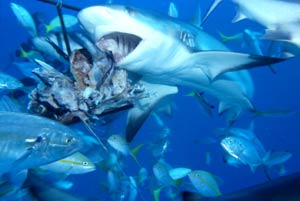
|
|
|
|
|
|
Shark Info (03-15-2001) |
Author |
|
Intro: |
Shark Info |
|
Main article: |
Dr. E. K. Ritter |
|
Article 1: |
John McKinney |
|
Article 2: |
Shark Info |
|
Article 3: |
Dr. E. K. Ritter |
|
Article 4: |
Shark Info |
|
Fact Sheet: |
Dr. E. K. Ritter |
|
GIMEC Meeting in New OrleansOn January 26 of this year, the GIMEC (Global Interactive Marine Experiences Council) met in New Orleans and presented the first model showing how diving should take place with marine animals in the presence of food/who are lured with food. Various public meetings on this theme were held last year in Florida. Feeding opponents wanted to put a ban on all feeding practices and have it legally anchored (SHARK INFO: 4/2000). The government was opposed to such a law, at the same time, however, it declared that an organization would have to be founded not only to control such feedings - mainly of sharks and fish - but also to give them some kind of organizational structure. The GIMEC was thus established and a model worked out which was now presented for the first time. Interactive diving in more than 300 locations and almost 40 countries
Various types of interactive diving with marine animals have existed since the early 70s. Also termed as an IME (interactive marine experience), this type of diving experience has in the meantime spread to more than 300 locations in almost 40 countries. Over the years, IMEs have made both divers as well as governmental offices aware that protective measures for marine organisms are necessary to preserve the ocean as a habitat and to enable continuing observations of marine animals. Here it appears that divers have become increasingly sensitized to this theme and are beginning to play a leading role in such efforts.
Calculated riskFeeding marine animals is an ambiguous subject and many organizations oppose it. In a recent press article, the Humane Society of the United States (HSUS), the largest animal protection society in the U.S., also criticized this practice, advocating a total ban on feeding sharks in Florida. On the one hand, the arguments of such opponents are understandable, yet facts are missing which would really substantiate such a ban. The Florida Government thus gave the diving industry an opportunity to establish rules and procedures which would make such feedings as safe as possible. Much time has passed since the first public hearings were held on this theme and it has become clear that the cause can only be furthered by an emotionless approach. Furthermore, it also became clear that no real danger exists for people who practice such feedings.
Various interest groups united in GIMECMembers of the GIMEC include commercial diving instructors, scientists from various faculties and other specialized groups. Together their first task was to establish guidelines and second to make sure these were followed with the objective of turning interactive diving into a valuable and accident-free experience. GIMEC objectives and assignmentsThe GIMEC has clearly formulated objectives. It sees itself mainly as a powerhouse for training people interested in IMEs and marine protection efforts, in addition to collecting data and facts and supporting scientific projects. Another one of GIMEC's goals should, however, also include making sure that those offering IMEs hold themselves to the respective guidelines. Its most important tasks include:
Shark Foundation mentioned in GIMEC ModelThe GIMEC also profits from various already existing experiences, projects and regulations, all of which are aimed at educating and awakening public understanding for the cause. Also included in this model is the recommendation to integrate the past efforts and resulting already applied principles developed by the Shark Foundation in Switzerland. Emphasis was placed on two points: Making the general public aware of the endangered situation of sharks and enabling them to react properly in their immediate encounters with these animals, the latter point worth being supported by all suppliers. The entire draft of the GIMEC Model is available from Shark Info. * Dr. Erich K. Ritter is a shark biologist and adjunct assistant professor at Hofstra University, New York (USA) May be published only by indicating the source: Shark Info / Dr. E. K. Ritter |
|
|
|
|
|
|||||
